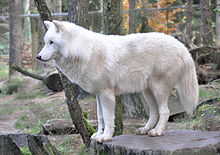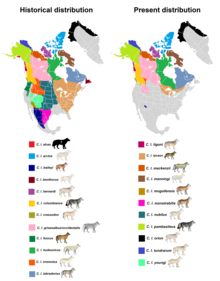
Back ذئب القطب الشمالي Arabic ذئب القطب الشمالى ARZ Idatcol (Canis lupus arctos) AVK བྱང་སྣེའི་སྤྱང་ཀི Tibetan Canis lupus arctos Catalan Canis lupus arctos CEB Vlk arktický Czech Polarulv Danish Polarwolf German Vergo sıpê DIQ
| Arctic wolf | |
|---|---|

| |
| Scientific classification | |
| Domain: | Eukaryota |
| Kingdom: | Animalia |
| Phylum: | Chordata |
| Class: | Mammalia |
| Order: | Carnivora |
| Family: | Canidae |
| Genus: | Canis |
| Species: | |
| Subspecies: | C. l. arctos
|
| Trinomial name | |
| Canis lupus arctos Pocock, 1935
| |

| |
| Historical and present range of grey wolf subspecies in North America | |
The Arctic wolf (Canis lupus arctos), also known as the white wolf, polar wolf, and the Arctic grey wolf, is a subspecies of grey wolf native to the High Arctic tundra of Canada's Queen Elizabeth Islands, from Melville Island to Ellesmere Island.[3] Unlike some populations that move between tundra and forest regions,[4] Arctic wolves spend their entire lives north of the northern treeline.[5] Their distribution to south is limited to the northern fringes of the Middle Arctic tundra on the southern half of Prince of Wales and Somerset Islands. It is a medium-sized subspecies, distinguished from the northwestern wolf by its smaller size, its whiter colouration, its narrower braincase,[6] and larger carnassials.[7] Since 1930, there has been a progressive reduction in size in Arctic wolf skulls, which is likely the result of wolf-dog hybridization.[7]
- ^ "Canadian Wildlife Species at Risk 2021". 2021-12-03. Retrieved 2023-10-14.
- ^ "Canis lupus arctos". Retrieved 2023-10-14.
- ^ Mech, L. David (1981), The Wolf: The Ecology and Behaviour of an Endangered Species, University of Minnesota Press, p. 352, ISBN 0-8166-1026-6
- ^ "Wolves".
- ^ "Arctic Wolf Facts and Adaptations - Canis lupus arctos".
- ^ Goldman, E. A. (1964). Classification of wolves. In The Wolves of North America Part 2. Young, S. P. & Goldman, E. A. (Eds.) New York: Dover Publs. p. 430.
- ^ a b Clutton-Brock, J.; Kitchener, A. C.; Lynch, J. M. (1994). "Changes in the skull morphology of the Arctic wolf, Canis lupus arctos, during the twentieth century". Journal of Zoology. 233: 19–36. doi:10.1111/j.1469-7998.1994.tb05259.x.
